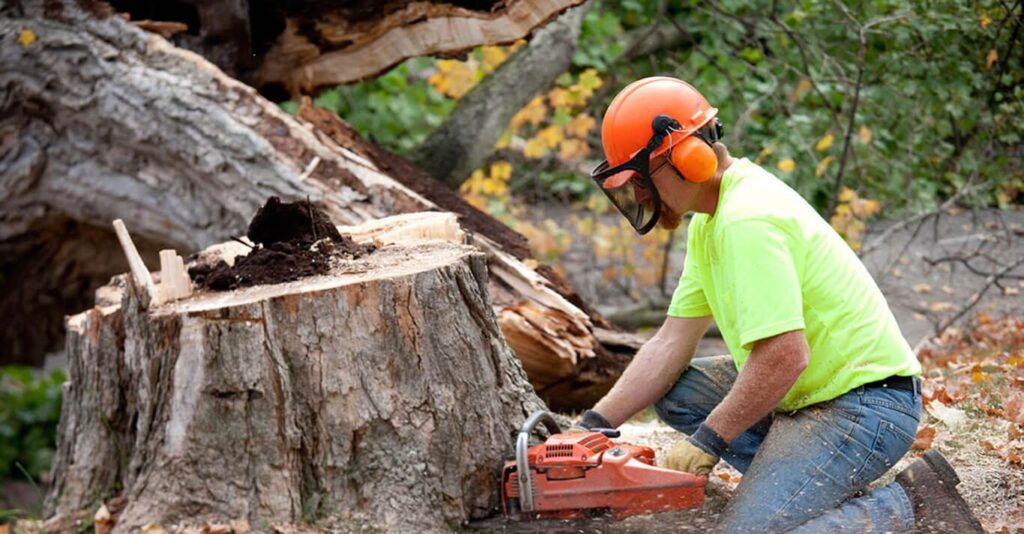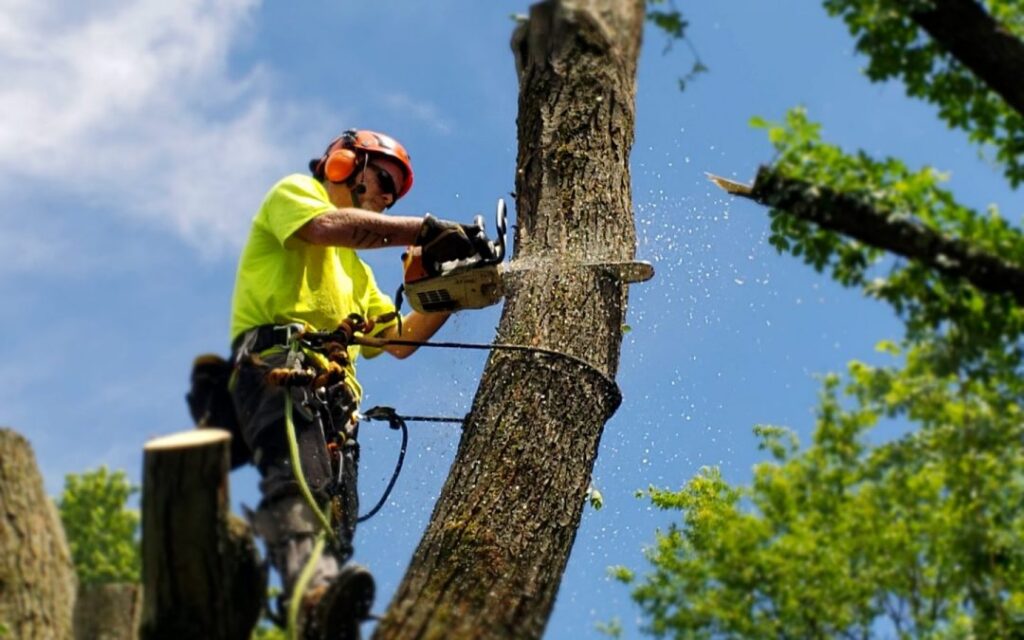Tree grinding has become a popular method for tree removal and disposal in recent years, thanks to its numerous benefits. Whether you are a homeowner or a professional landscaper, understanding tree grinding can help you make informed decisions about tree maintenance and contribute to the sustainability of your environment. In this article, we will delve into the process of tree grinding, the tools and equipment used, and the various benefits it offers.
What is Tree Grinding?
Tree grinding is a technique used to remove tree stumps and roots from the ground by grinding them into small wood chips. This process is carried out using heavy machinery equipped with sharp teeth or grinding blades. Unlike traditional methods, such as excavation or chemical stump removals, tree grinding is efficient and environmentally friendly.
The Process of Tree Grinding
When a tree is cut down or falls, its stump and roots are often left behind, which not only detracts from the aesthetics of your landscape but can also pose safety hazards. Tree grinding starts with the positioning of the grinder near the stump. The grinder is then gradually lowered onto the stump, and the rotating blades or teeth reduce it to wood chips. The process continues until the entire stump is ground down and only wood chips remain.
After the grinding is complete, the wood chips can be left on the ground as mulch or removed for other purposes. The choice depends on your preferences and the specific needs of your landscape.
Tools and Equipment Used in Tree Grinding
Tree grinding requires specialized equipment to ensure effective and safe removal of stumps. The most commonly used machine is called a stump grinder, which is equipped with a powerful engine and a cutting wheel. The cutting wheel can vary in size depending on the size of the stumps to be removed.
Additionally, safety measures are essential in tree grinding operations. Operators must wear protective gear, such as gloves, goggles, and ear protection, to minimize the risk of injury. It is crucial to engage the services of experienced professionals who are well-versed in using the equipment and following safety protocols.
Furthermore, the process of tree grinding involves more than just the machinery and equipment. It requires careful planning and assessment of the site. Before starting the grinding process, it is important to identify any underground utilities or obstacles that may be present. This ensures that the grinding operation does not cause any damage to underground infrastructure or other structures in the vicinity.
Tree grinding offers several benefits
Moreover, tree grinding offers several benefits beyond stump removal. The wood chips produced during the grinding process can repurposed as mulch, which helps retain moisture in the soil, suppresses weed growth, and improves the overall health of your landscape. Alternatively, the wood chips can used for other purposes, such as biomass fuel or composting.
Overall, tree grinding is a versatile and effective method for removing tree stumps and roots. It combines advanced machinery, skilled operators, and careful planning to ensure safe and efficient removal. By choosing tree grinding, you not only enhance the appearance of your landscape but also contribute to a more sustainable and eco-friendly approach to stump removal.
The Importance of Tree Grinding
Tree grinding plays a significant role in both landscape maintenance and tree health. Understanding its importance can help you make informed decisions regarding the management of trees on your property.
When it comes to landscape maintenance, tree grinding offers a multitude of benefits beyond just aesthetics. By removing tree stumps, you are preventing potential hazards such as tripping or injuries, especially in high-traffic areas. Additionally, decaying stumps can attract unwanted pests like termites, which can pose a threat to not only your trees but also nearby structures. Tree grinding ensures that your landscape remains safe and free from these risks, providing a secure environment for both residents and visitors.
Role in Landscape Maintenance
Stumps left behind after tree removal can be eyesores in your landscape. They can also hinder mowing, landscaping, or construction activities. Tree grinding eliminates these impediments, allowing for a cleaner and more aesthetically pleasing landscape. It creates a blank canvas for new plantings or other outdoor projects, enhancing the overall appeal of your property.
Furthermore, the process of tree grinding can also improve the soil quality in your garden or yard. As the stump is ground down into wood chips, these organic materials break down over time, enriching the soil with essential nutrients. This natural fertilization can benefit the growth of other plants in the vicinity, creating a healthier and more vibrant ecosystem within your landscape.

Contribution to Tree Health
While some homeowners may consider letting tree stumps decay naturally, this process can take years and can attract pests and diseases. Decaying stumps can also serve as breeding grounds for fungi and bacteria that may spread to healthy trees. By grinding stumps, you eliminate these potential threats and promote tree health and longevity. Click here to learn more about professional stump grinding.
In addition to preventing the spread of diseases, tree grinding can also stimulate new growth in surrounding trees. By removing the old stump, you are allowing more space and resources for nearby trees to flourish. This can lead to improved canopy development and overall tree vitality, creating a more resilient and thriving ecosystem within your property.
Environmental Benefits of Tree Grinding
In addition to improving the aesthetics of your landscape and ensuring the health of your trees, tree grinding offers several environmental benefits.
Waste Reduction and Recycling
Tree grinding reduces the amount of organic waste sent to landfills, contributing to waste reduction efforts. The resulting wood chips can repurposed as mulch or compost, providing natural benefits to your garden or landscaping projects. Recycling these wood chips helps to close the loop and promote sustainability.
Soil Enrichment and Ecosystem Support
When wood chips can left on the ground, they gradually decompose and enrich the soil with organic matter. This enhances soil fertility and promotes the growth of beneficial soil microorganisms. Furthermore, the presence of wood chips on the ground provides a habitat for insects, birds, and other wildlife, fostering a healthy ecosystem in your landscape.
Moreover, the decomposition of wood chips releases nutrients back into the soil, creating a natural cycle of replenishment that benefits the entire ecosystem. As the wood chips break down, they improve soil structure, helping to retain moisture and prevent erosion. This process also supports the growth of plants by providing a steady supply of nutrients over time, contributing to the overall health and vitality of your landscape.
Additionally, the presence of wood chips on the ground can act as a natural weed suppressant, reducing the need for harmful chemical herbicides. By creating a barrier that inhibits weed growth, wood chips help to maintain the balance of plant species in your landscape, promoting biodiversity and creating a more resilient ecosystem. This natural weed control method not only benefits the environment but also reduces the maintenance required to keep your landscape looking its best.
Economic Advantages of Tree Grinding
Aside from the environmental benefits, tree grinding also offers economic advantages that make it an attractive option for homeowners and businesses alike.
When considering the economic benefits of tree grinding, it’s important to note that this method not only saves money in the short term but also contributes to long-term cost savings. By effectively removing stumps and roots through grinding, you eliminate the need for ongoing maintenance that may required with other methods. This can result in significant savings over the lifespan of your property, making tree grinding a wise investment.
Cost-Effective Tree Management
Compared to traditional methods of stump removal, such as excavation, tree grinding is often more cost-effective. Excavation can be labor-intensive and time-consuming, requiring heavy machinery and skilled operators. Tree grinding reduces the time and effort required for stump removal, making it a cost-effective solution for both small-scale and large-scale tree management projects.
Furthermore, the cost-effectiveness of tree grinding extends beyond just the removal process. The wood chips produced during grinding can also benefit your property by acting as a natural mulch, helping to retain soil moisture and suppress weed growth. This dual functionality not only saves you money on purchasing mulch but also promotes the health and longevity of your landscaping.
Potential for Profitable Byproducts
The wood chips obtained from tree grinding have various potential applications and can be a valuable byproduct. They can used for landscaping, gardening, or even as biomass fuel. Some tree grinding service providers may offer to purchase the wood chips, providing an additional revenue stream for your tree management operations.
Exploring the potential for profitable byproducts from tree grinding can open up new opportunities for revenue generation. For example, partnering with local nurseries or landscaping companies to supply them with wood chips can create a mutually beneficial relationship that not only offsets your own costs but also boosts the sustainability of your tree management practices. By tapping into these secondary markets, you can maximize the economic benefits of tree grinding and turn what was once a cost into a profitable venture.

Safety Aspects of Tree Grinding
While tree grinding is an effective and efficient method, safety should always be a top priority when dealing with heavy machinery and equipment.
Tree grinding is not only about enhancing the aesthetics of your landscape but also about ensuring the safety of everyone around. It is crucial to assess the surrounding area for any potential risks before starting the grinding process. This includes checking for underground utilities, nearby structures, and ensuring there are no bystanders in the vicinity.
Preventing Tree-Related Hazards
Dead or decaying trees can pose serious risks, as they may fall unexpectedly, endangering lives and damaging property. By grinding the stumps and roots, you eliminate these potential hazards, making your landscape safer for residents, visitors, and passersby.
Furthermore, removing old tree stumps can prevent pests and insects from making it their home. Rotting wood can attract termites and other unwanted critters, which can eventually spread to healthy trees in your garden, causing extensive damage.
Safe Operation of Tree Grinding Equipment
Tree grinding is perform by trained and experienced professionals who adhere to safety protocols. Operators must take precautions to avoid injuries, including proper attire and the use of safety equipment. Regular maintenance of the grinding equipment is also crucial to ensure safe and efficient operation.
Before starting the tree grinding process, it is essential to inspect the equipment thoroughly. Check for any loose parts, leaks, or signs of wear and tear that could potentially lead to malfunctions during operation. Proper calibration of the machinery is key to achieving the desired results without compromising safety.
In conclusion, understanding tree grinding and its benefits is essential for anyone responsible for tree management or landscaping. By comprehending the process, tools, and equipment involved, as well as the various environmental, economic, and safety advantages it offers, you can make informed decisions and contribute to maintaining a healthy and sustainable environment for generations to come.

